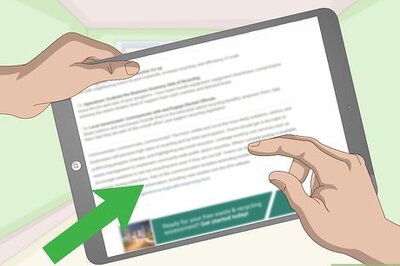
views
The nation is holding on to its sigh of relief at the waning of the second wave, as there is the apprehension of the dire prospect of a third wave. There have been predictions galore, with some retractions, clarifications and caveats following the predictions. However, the prospect of a third wave appears to have been accepted as a near certainty. Two recent predictions buttress this belief. The SUTRA model, developed by a government constituted panel of scientists, predicts the third wave to hit the country during October-November this year. A report prepared by State Bank of India Research anticipates that the third wave will commence in the second half of August and peak in September.
These predictions are derived from meticulously crafted mathematical models. The virus may be creating its own models for new mutations. The variants that emerge may defy the assumptions that underlie the models. The modellers do caution about the predictions going astray because of new and more infectious variants emerging. If they do, all bets are off, on the timing and severity of the third wave. The other imponderables are the extent to which people will adhere to advisories, on masks and avoiding crowds, as well as the resolve and ability of authorities to curb superspreader events.
The question in most minds is not whether but when and where the third wave will first appear. The calendar of that wave is uncertain. Like the second wave, different parts of India may experience it at different periods within a broad time frame. Even as of now, there are parts of India with high test positivity rates and rising daily case counts. The north-eastern states are displaying this delayed rise, compared to the rest of the country. The second wave has not receded uniformly across the country. Very recently, the Director General of the Indian Council of Medical Research cautioned that 80 districts still have high test positivity rates.
While the second wave has sharply plummeted in several states of the country, the numbers have only plateaued on a slow decline in Maharashtra and Kerala. These western states were also among the early ones to be affected in the first and second waves. Will they also initiate the third wave or will they have crossed by then into the protective zone of ‘herd immunity’, due to the large numbers already infected? While there is considerable speculation on this, both states are taking no chances. They are preparing for a possible third wave, on the assumption that it could be severe.
There are several reasons why some states are affected more or earlier than others. The extent of urbanisation and population density are important determinants of the speed and spread of viral transmission. Maharashtra is an economically developed state with several cities and industrial zones that have a high population density. Of the top 30 most-populated urban agglomerations in India, eight are in Maharashtra. Mumbai, in particular, has several slums densely packed with people. Kerala does not have many large cities but has very little distinction between its urban and rural components, with emphasis on equitable development blurring the differences that sharply demarcate less-developed rural areas in many other states.
Travel intensities, into and within the states, too predict the ease and extent of viral transmission. Maharashtra has a high number of travellers and daily commuters. Mumbai, the commercial capital of the country, has many visitors arriving by air, rail, road and sea. Many commute daily to work, in crowded local trains. The high numbers of industrial, commercial and educational centres in the state, as well as many sites of pilgrimage and tourist attraction, constantly catalyse the churn of people. Some of them will carry the virus, posing danger to many others.
Kerala too has high travel density. Though not economically as well-developed as Maharashtra, it is a major tourist attraction for both Indian and foreign visitors, because of its natural beauty, cultural diversity and traditional healing systems. It has a large number of its people working or studying outside the state, within India or abroad. They travel back to the state to visit families. A large number of migrant labourers too work in Kerala. Kochi’s growth has also brought many skilled workers to the state, from other parts of India. Travel between Kerala and neighbouring states is also high.
Will Maharashtra and Kerala be the bellwether states for the third wave too? Proponents of herd immunity believe that the high numbers of people already exposed to the virus in the first two waves would have acquired immunity, vastly reducing the number of susceptible persons in these two states. While statewide antibody surveys are not available, some of the city-level surveys have indicated high seropositivity rates, especially in Mumbai’s slums. However, the extent and duration of protection conferred by such antibodies are uncertain. These surveys do not tell us whether the antibodies detected are capable of neutralising the virus or not. We do not know how effective they are against the variants, especially the Delta variant, which seems to evade these antibodies with considerable success.
Antibody surveys are useful for evaluating how effective our containment measures have been in curtailing viral transmission in a state or city, by comparing positivity rates over two time periods. They do not give us dependable information on how protective the detected antibodies are for assessing the level of assured immunity in population groups or even in individuals. As new variants surface and circulate, the antibody surveys become even less predictive of protective immunity. Predictions of herd immunity, based on antibody surveys and mathematical models, have proved to be wrong and misleading in the past.
Vaccination does confer more predictable immunity that assuredly confers protection, not from all infection but substantially from the dangers of severe illness and death. Even though the Delta variant does appear to dampen some of the immune protection offered by vaccines, two doses of the available vaccines do confer adequate protection to most recipients. However, the levels of full vaccination are unlikely to cross 50% by August and 70% by October among all adults in the two states. If we speed up inoculation, enabled by the availability of more vaccines by August, we may depend on some additional numbers of persons who may have acquired protective immunity from infections in the past six months.
Other states with high levels of urbanisation and travel intensity can also initiate the third wave. Delhi has the propensity to experience periodic surges, despite frequent claims of herd immunity. It is also the gateway to many neighbouring states whose level of caution may be low. Rural areas were protected during the first wave but were indiscriminately opened up for viral invasion from urban areas. Vaccination rates are still to pick up in rural areas. Abandonment of caution in personal behaviour or public policy can make it easy for the virus to rise and race again from any starting point in the country. Especially, if we give it opportunities to mutate through slow vaccination.
As we ramp up vaccination rates, we must ensure that we also deny the virus an opportunity for easy transmission. All proven public health measures must be deployed. Surveillance, to detect new cases and virus variants, must be scaled up. Non-essential travel must be restricted. Masks must be made mandatory outside of home. Large gatherings must be prohibited. Caution must prevail over carelessness, even as proactively prudent preparation for the third wave must replace the inertia of irresolute panic. Only then can we rewrite the script of the West Side Story in the Covid sequel that is projected to appear on our screens in the coming months.
Read all the Latest News, Breaking News and Coronavirus News here.



















Comments
0 comment